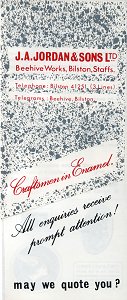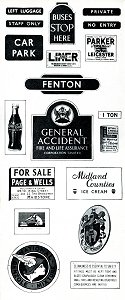 |
Ralph and Jordan
|
 |
A brief history by Reg Aston
|
Records indicate that the company was established about 1870. There are mentions in a Post office Trade Directory of 1872 of a James Ralph & Company, frying pan maker of Earl Street, Bilston. In 1896 Kelly's Directory for Staffordshire lists both James A. Jordan, holloware; and Ralph & Jordan, wrought iron, holloware manufacturer, tinners, galvanisers and manufacturers of enamelled iron advertisement plates, Beehive Works, Earl Street, Bilston. In 1893, in his History of Bilston, Lawley has this to say about the company:
Unfortunately nothing more is known of their bicycle making activities. Although they may have continue for some years as makers of holloware, vitreous enamelling became their main activity. |

Sign by Jordans, photographed in situ |
The processes involved in enamelling were not without its dangers to
the employees.
On 12th June 1893 Harriet Walters of Sedgley died
an agonising death. The Coroner returned a verdict of "Death
from chronic lead poisoning accidentally contracted through her
employment". Five months prior to her death she had been
earning her living as a "brusher" at Ralph & Jordan
enamelling works.
The verdict was greeted with so much protest that eventually questions were asked in Parliament which resulted in the setting up of a special committee to investigate the enamelling industry in general. |
The company's main business was the production of enamelled advertising signs. A full colour catalogue issued in 1918 proudly displayed signs produced for some of the most well known national and local companies, including Wearwell Cycles, complete with its winged wheel logo.
| Trade directories of 1924 indicate that by this time the company had become known as J.A. Jordan & Sons Ltd. The following decades showed expansion with the building of additional premises, with one side of Earl Street dedicated to the enamelling of gas cookers, while the other side looked after enamelled signs of all shapes and sizes, including bus stop signs, road signs, signs for tea, chocolate and cigarettes. Almost certainly the "Players" cigarettes advert was the most famous with the "Sailor" design recognised everywhere. |

an advert from a trade directory of 1920 |
Some designs were indeed a work of art and they employed artistic designers to produce this type of sign. A stencil was cut for each colour which was applied and fired separately. The mixing of the correct proportion of the various ingredients to produce each colour was critical, as was the ability to withstand repeated firings. It is said some of the secrets of the trade were lost when key important employees retired taking their "recipes" with them. This would, no doubt, have added to the decline in the company's fortunes but the firm's work with vitreous enamels was supported by chemists and laboratories in Greencroft. |
 An advertisement, undated.
An advertisement, undated. |
  |
During the 1950s and 1960s the firm diversified into the wind
rotating advertising signs that normally appeared on garage forecourts
and into station name plates for British Rail.
The brochure (of which the front cover and one inner page are shown to the left, undated, probably from the late 1950s, shows signs for British Rail, international companies such as National Benzole, HMV and Coca Cola and a local company, Midland Counties Ice Cream. |
 |
Although Jordans continued to be most famous for
their advertising signs, they continued with other enamelling
work, which included the enamelling of the type of cast iron
fireside furniture best represented by the Bilston
Knights.
Their entry in the 1974 Wolverhampton Official Handbook says: "Vitreous enamelling of steel and cast iron. Manufacturers of architectural panels. Press work capacity up to 350 tons, spot welding undertaken". The "architectural panels" were fire resistant panels used on the facades of large buildings. |
On the following pages there are many examples of Jordans work taken from a number of documents, particularly a surviving catalogue. (Thanks to the Black Country Living Museum for providing scans of most of the documents shown, from their archives).
 Return to the industry front page |
Return to main Index |
 Proceed to the Catalogue |